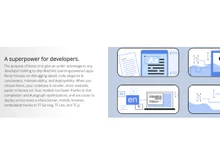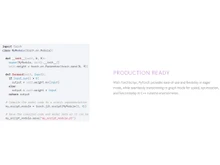Keras and PyTorch are two prominent deep learning frameworks having their own set of strengths and functionalities. Keras is known for its high-level abstraction and user-friendly interface. Apart from that, it offers seamless integration with TensorFlow and focuses on rapid prototyping. On the other hand, PyTorch is popular for its dynamic computation graph and flexibility. It caters to users who are looking for robust control and fast performance. In this quick comparison between them, we'll explore their differences and strengths across various key aspects. This will help you understand respective features, use cases, and more within the deep learning community.
Keras vs. PyTorch: An Overview
Keras is an open-source high-level neural network API written in Python and designed for fast experimentation. It serves as an intuitive and user-friendly interface, allowing developers to build and experiment with neural network models for machine learning. Keras provides a modular and extensible platform that is well integrated with TensorFlow, for creating and deploying deep learning models.
In contrast, PyTorch is an open-source machine learning software that is based on the Torch library and written in Python. It offers a flexible approach to build and train neural networks, with support for GPU acceleration and distributed computing. Apart from that, it seamlessly integrates with popular datasets. PyTorch's dynamic computation graph and focus on simplicity and flexibility make it a preferred choice for research and deep learning.
PyTorch vs Keras: Key Differences
Here are a few major differences between Keras and PyTorch:
- Keras provides a high-level abstraction for building neural networks, while PyTorch and a few PyTorch alternatives offer both high-level abstractions and low-level access for more control and customization.
- PyTorch is known for its flexibility in research and deep learning whereas Keras is known for its user-friendly interface and integration with TensorFlow.
- Keras and a few Keras alternatives use static computation graphs, while PyTorch employs dynamic computation graphs, allowing for more flexibility in building and modifying models during runtime.
- PyTorch is released under a BSD (Berkeley Source Distribution) license, but Keras is licensed under the MIT (Massachusetts Institute of Technology) license.
Keras and PyTorch: In Terms of Features
- Debugging: Keras offers a user-friendly interface for debugging, with integrated tools for visualization. However, in comparison to Keras, PyTorch provides more explicit and robust debugging, allowing users to inspect and manipulate tensors at different stages of computation.
- Pretrained Models: Keras offers pre-trained models through TensorFlow Hub and Keras Applications, enabling easy transfer learning and model reuse. On the other hand, PyTorch offers pre-trained models through the TorchVision library, particularly in computer vision, and facilitates transfer learning tasks.
- Computation Graphs: Keras uses static computation graphs while PyTorch employs dynamic computation graphs, allowing for more flexibility in building and modifying models.
- Memory Management: Keras handles memory management through its backend, primarily TensorFlow or Theano, with optimizations for efficient memory usage. PyTorch's dynamic graph execution allows for more efficient memory management and reduced memory overhead.
- Visualization: Keras includes built-in tools for visualization, such as TensorBoard, for model visualization and monitoring. On the other hand, PyTorch doesn’t have any built-in tools of its own but integrates with tools like TensorBoardX and Visdom for visualization.
PyTorch vs Keras: API Level
Keras provides a high-level neural networks API that is user-friendly and designed for fast experimentation. This allows for easy and fast prototyping. PyTorch, on the other hand, offers a more low-level approach, allowing for more flexibility and control over the neural network model.
Keras or PyTorch: Architecture
Keras is built on a modular and intuitive design that allows for the easy creation of complex neural network architectures. In contrast, PyTorch's architecture is based on dynamic computation graphs, enabling more flexibility in building, and modifying models.
PyTorch vs Keras: Datasets
Keras supports various datasets through its integration with TensorFlow, such as MNIST, CIFAR-10, and more. Whereas PyTorch provides seamless integration with popular datasets like ImageNet, CIFAR, and COCO through its TorchVision library.
Keras vs. PyTorch: Speed & Performance
Keras, integrated with TensorFlow, delivers high performance for production deployment and supports distributed training. PyTorch, on the contrary, is known for its GPU utilization for high-performance computing tasks.
PyTorch vs Keras: Language Written In
PyTorch is implemented in C++ with a Python API, allowing for flexibility and performance optimization. On the other hand, Keras is primarily written in Python, along with TensorFlow serving as its backend.
Keras and PyTorch: Community Support
Keras offers community support via TensorFlow's extensive resources, including documentation, forums, and tutorials. PyTorch, on the other hand, has a rapidly growing community with active development, comprehensive documentation, and presence on platforms like GitHub and Stack Overflow.
PyTorch vs Keras: Backend Support
Keras supports multiple backends, with TensorFlow and Theano being the primary choices. PyTorch is designed to work seamlessly with CUDA for GPU acceleration, making it a preferred choice for GPU-based computations.
Keras vs. PyTorch: Ease of Use/ User Interface
In terms of ease of use, PyTorch offers a more flexible and granular interface, allowing for greater control and customization. However, it is complex to use at the same time. Keras, on the other hand, is known for its user-friendly interface and ease of use, making it suitable for beginners and rapid prototyping.
PyTorch vs Keras: Cross-Platform Portability & Exporting Models
Keras being integrated with TensorFlow provides cross-platform portability for models including mobile and web. Models can be exported to TensorFlow's SavedModel format. PyTorch offers robust support for exporting models to the ONNX (Open Neural Network Exchange) format, enabling cross-platform deployment and interoperability with other frameworks. This allows PyTorch models to be used across various platforms and integrated into different production environments.
Verdict: Keras vs. PyTorch
In summary, Keras and PyTorch offer distinct approaches to deep learning, with Keras emphasizing high-level abstraction and user-friendliness, while PyTorch provides a balance of high-level and low-level control, particularly through its dynamic computation graphs. Keras is widely popular for its integration with TensorFlow and ease of use, drawing a large user base, while PyTorch has gained popularity in research and deep learning communities due to its flexibility and active development. Both frameworks also have different licensing.


 4 Ratings & 0 Reviews
4 Ratings & 0 Reviews

















